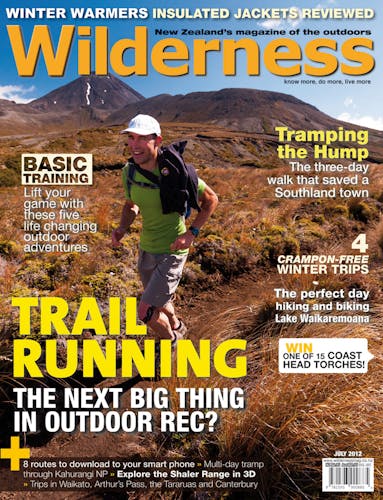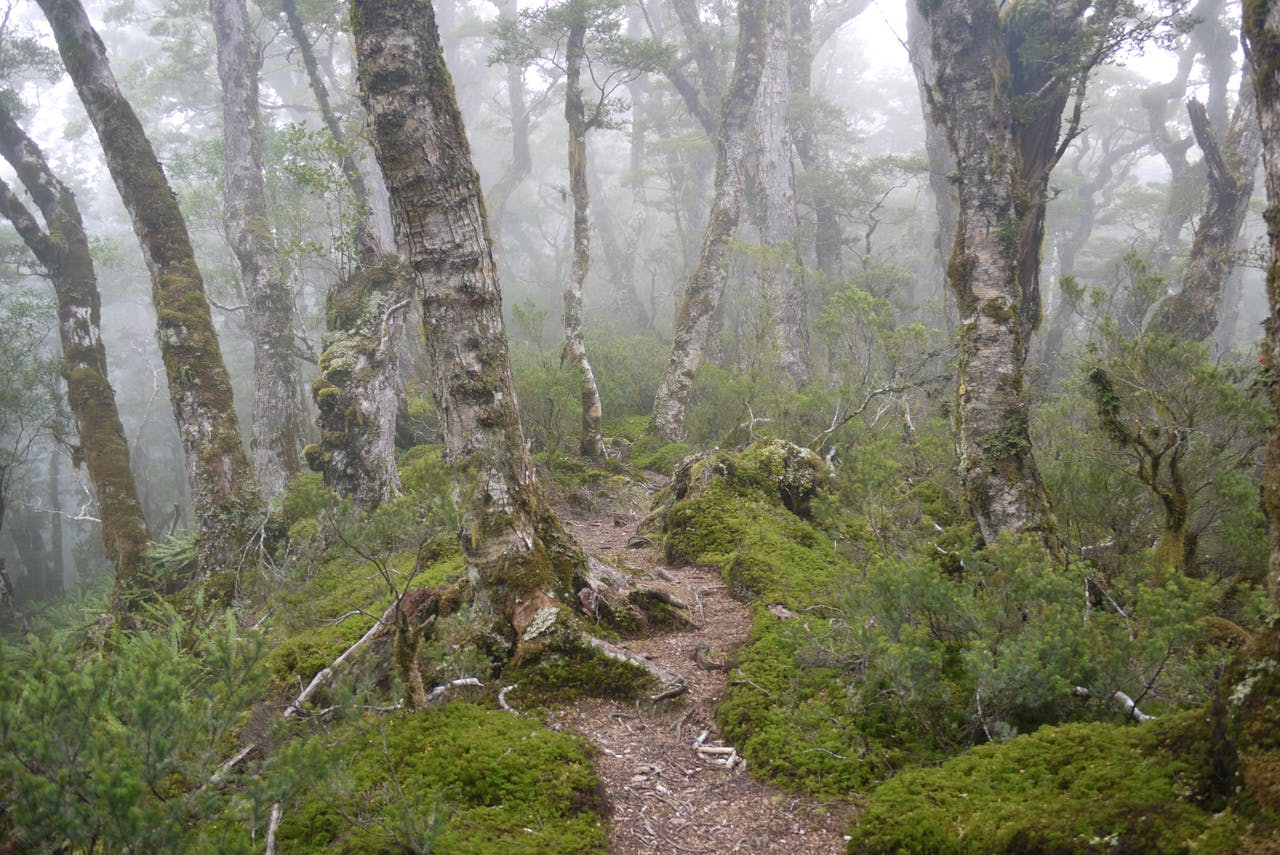- Time
- Three days
- Grade
- Easy/Moderate
- Accom.
- Private accommodation is provided at Okaka Lodge an Port Craig Lodge. Sleep in dorms or splash out on a private room
- Access
- From Rarakau car park (leave a gold coin donation), 30min from Tuatapere
Tuatapere’s future had ghost town written all over it. But then the community built the Hump Ridge Track and brought their town back from the brink. Alistair Hall discovers just what a great job they’ve done
Between laboured puffs I reflect on Kate Hebblethwaite’s words from the night before.
“You’ll be pulling yourself up by branches and tree roots – it’s not the Kepler, we like to keep it challenging,” Hebblethwaite, operations and marketing manager with Tuatapere Hump Ridge Track, had promised during the obligatory pre-walk talk. At the time I was pleased to hear the three-day private track still offered a challenge to trampers. I’d just declined an offer to have my pack flown to Okaka Lodge – the first night’s accommodation – though I had accepted an upgrade to a private room. Without a sleeping bag to carry, my pack would be ludicrously light and I felt I needed to make at least a pretence at tramping.
But now, catching my breath in a cool swirl of cloud with sweat running down my face, I realised my fears about an all too easy walk in the park were unfounded. I wasn’t on hands and knees just yet – the 11km of boardwalk and more than 1000 steps found on the track make that a virtual impossibility – but the climb from sea level to Pt765 had sure knocked the wind out of me.
I looked down the Hump Ridge and through breaks in the moss-dripping beech forest spied Ian and Lynne Lockhead. The Christchurch couple were at least 12 years my senior, but I couldn’t shake them. Lynne reached me and smiled, sweat also running down her face. It’s Easter but the deep south is basking in glorious weather. The cloud cover which we have finally reached has only served to make the forest more humid.
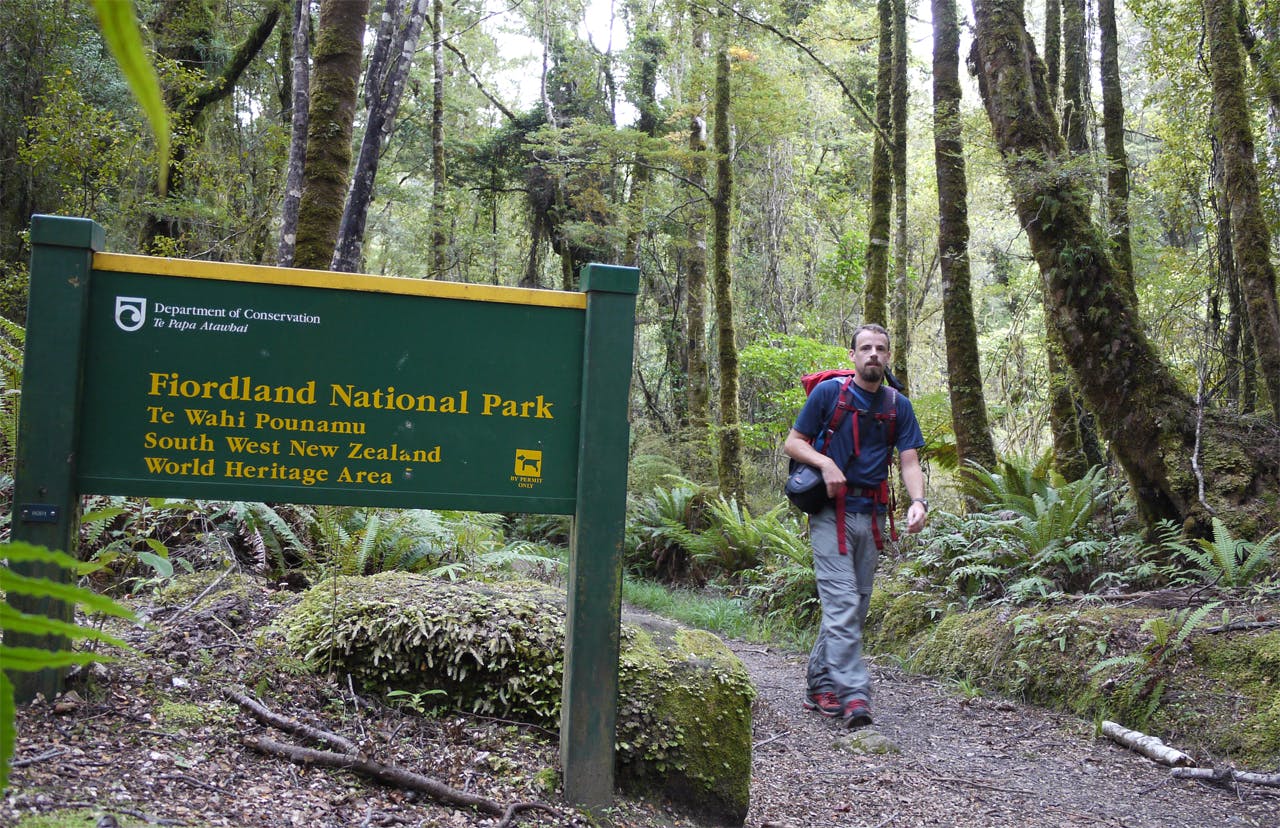
The track is the only private track in the country that passes through a national park. Photo: Alistair Hall
“The climb hasn’t been as bad as I was led to believe,” Lynne says. I nod in agreement, pretending to be fitter than I really am. ‘‘I climbed Mt Misery two weeks ago and that was misery!” she adds.
I first bumped into Lynne and Ian a few hours earlier when the Hump Ridge Track turned inland, away from the South Coast Track, and entered Fiordland National Park. It was good to be amongst the forest after 3km of beach walking. They were in the middle of a break and I was in need of one.
I dropped my pack and on hearing they were from Christchurch asked how they had coped with the earthquakes.
“It’s good to get out of Christchurch,” Ian said. “The damage caused by the earthquake is nothing compared to what Gerry Brownlee has done.”
No love lost there, but Ian is a professor of art history and lectures on architecture at the University of Canterbury so it’s easy to see why he holds such animosity towards the officials who have presided over the rebuild of Christchurch which seems to have been all about taking things down rather than building them up.
Soon I’ve broken through the clouds and am on the open tops, above the bushline. More boardwalk leads the way to the lodge. Earlier that day, sections of boardwalk had passed through stunning podocarp and beech forest. Here on the tops, the wooden walkway protects fragile alpine flora and fauna, while in the forest it’s more about protecting walkers, and the track, from mud and bog.
Timberlands once managed the Hump Ridge and provided good forestry jobs up until 1994. Then the Helen Clark-led government banned exports of native timber. Residents of Tuatapere saw the writing on the wall: another round of job losses and population drain to match the closure of the Forest Service in 1984. But this time the community fought back. It formed a trust to investigate the feasibility of building a track up the ridge and back down the other side. Maybe tourism could revive the dying town? No longer able to harvest trees, Timberlands okayed the idea and then came the six-year-long process of gathering signatures of some 2000 people who needed to give consent for the track to pass over various tracts of private and Maori tribal land.
Feasibility studies were commissioned, consultants brought in, resource consents applied for. In the space of a few short years the trust had spent more than $400,000 without so much as nailing two pieces of boardwalk together.
Then came another blow to the community. The Fiordland National Park boundary was shifted a few clicks east to encompass the Hump Ridge.
“That’s when all our problems really hit the fan,” Ali King, who co-manages the track for the trust with his wife Trish, told me. “Of course straight away the Department of Conservation ceased all negotiations. They said there’s no way we would be allowed to build a track up there because there was no privatisation of any sort in a national park. We had already spent a huge amount of money up until then doing feasibility studies. That’s when the trust got a bit doggy, as you say. We threatened to take DOC to the land court to get it done.”
Helen Clark, a keen tramper, personally intervened and helped shepherd the project through a maze of DOC legalese.
Okaka Lodge is more than a place to sleep – it’s also the highlight of the trip. A short, boardwalked circuit from the lodge leads to a highpoint overlooking the sprawling complex and provides outstanding views of the area. Giant tors and a large tarn complete the picture. While everyone else made their dinner, brought in late by the helicopter thanks to the doggedly persistent cloud cover, I strode up the hill to the rocky ridge summit. Away from the bustle of the lodge, I gazed in amazement to the Cameron mountains and north to the far-off Takatimus while a full moon climbed high into the sky. Cloud filled the valleys, gently rising and falling on the breeze.
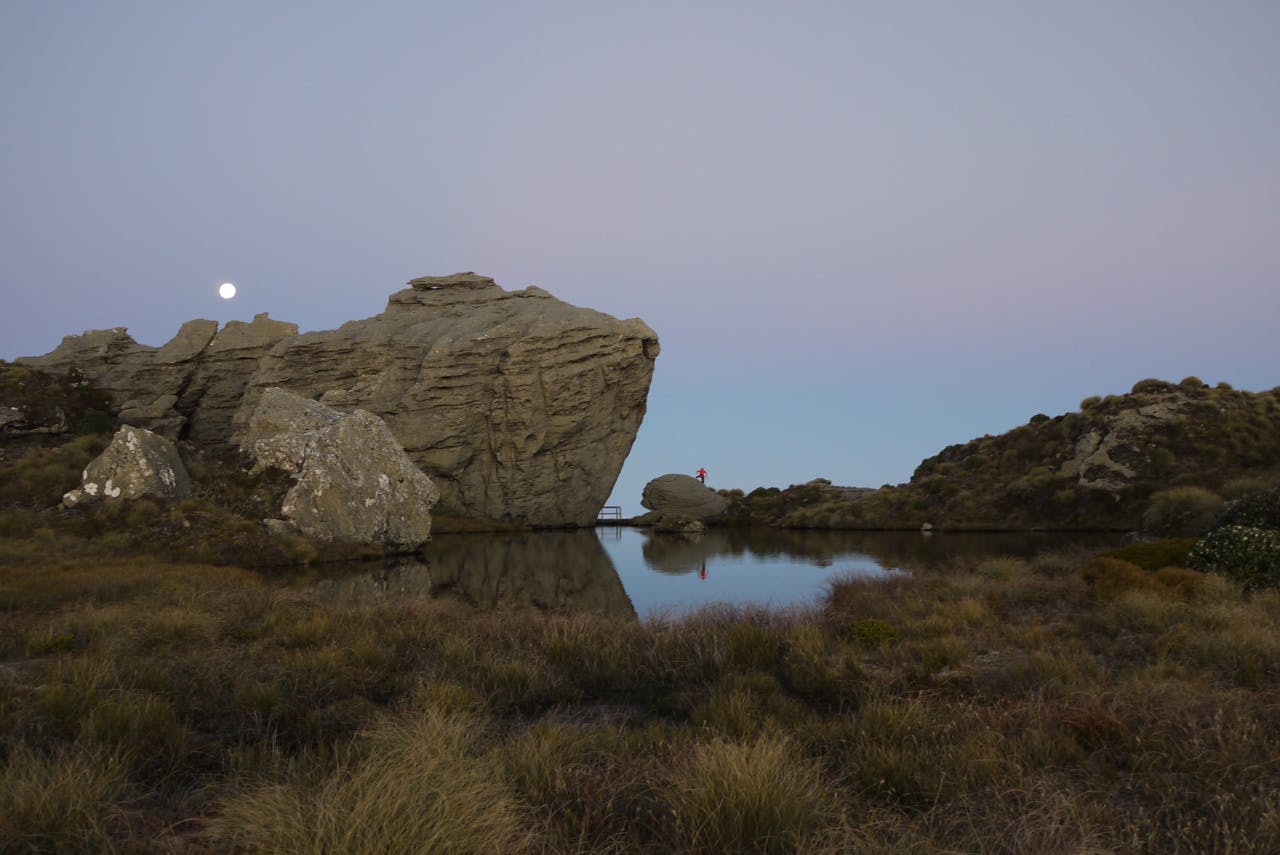
A full moon rises above the large tarn and rock features on the Hump Ridge. Photo: Alistair Hall
Back at the lodge, most walkers – and there are about 20 of us, none looking older than 50 and most a lot younger – sit in the lounge where the fire is roaring and drink beer or wine. Ian and Lynne’s son, who guides on the track during summer, has gifted them a bottle of Fiordland pinot noir which can be bought from the lodge warden. They share it around and it’s a darn good tipple, easily the match of many Otago pinots.
In contrast to the previous day, the route to Port Craig Village, an old logging settlement abandoned in the 1930s, is all downhill and there’s hardly any puffing involved. It’s still a long day though – a good 19km to the village. There are some steep sections and, apparently, good lookouts, though the cloud cover is persistent and all we get to see is white on grey.
Once back in the bush, the view doesn’t really matter. Here clouds turn to wispy mist, curling around trees and occasionally letting shafts of sunlight filter through before closing up again. South Island robins hop from branch to branch and the unmistakeable flapping of kereru can be heard in the canopy overhead. The Hump Ridge Track trust has teamed up with Wairaurahiri Jet to keep predators like stoats out of the bush. Both outfits maintain trap lines and the ones on the Hump Ridge have caught 27 stoats and rats in recent months. With the Wairaurahiri traps they form a barrier protecting the Waitutu Forest from reinvasion after a massive 1080 poison drop in the area some 18 months ago. Track manager Trish King later tells me the anecdotal evidence points to greater bird song and more bird sightings. I’m delighted with my tally of kereru, robin, fantail, tui and bellbird.
At one point, a bearded runner carrying walking poles zooms past, heading in the opposite direction. It’s perplexing. He’s a long way from any hut and he can’t be going to Okaka Lodge. I surmise he’s a trail runner doing some hard core training. It’s not beyond the realms of possibility – just a few weeks earlier, a 14-year-old local boy competed in the annual Stump the Hump 24hr run/walk. His time for the full 53km? Just shy of 13 hours.
Reaching the bottom of the ridge, the track joins the DOC-maintained South Coast Track and follows an old tramway through regenerating forest all the way to Port Craig, crossing three historic viaducts along the way, including Percy Burn, opened in 1925 and, at 36m above the river, the highest wooden viaduct in the world.
The forest here is a pale comparison to that found elsewhere on the Hump Ridge Track – legacy of the destructive logging that occurred here until the late 1930s. Interpretation panels detail some of the history of the area and as I bounce under my light load from rail sleeper to rail sleeper it strikes me that even though the area has a turbulent past that saw local Maori fall into poverty after being dispossessed of their land and the logging of native timber that stripped the forest from the land, Tuatapere has made a comeback.
Before starting the tramp, I spoke with Craig Rutland, who owns and runs Last Light Lodge in Tuatapere. Without the Hump Ridge Track he said he wouldn’t have a business to run – 90 per cent of his customers walk the track. Other accommodation providers have popped up too, including a second backpacker’s lodge and two B&Bs.
I asked Ali King how the track had impacted on the town. He told me after the Forest Service closed up shop in 1984 the town’s population fell from 1000 to around 750. It’s still around that mark today, despite the loss of more forestry jobs in 1994 when the ban on native logging took effect.
“My opinion is it has saved the town from being a ghost town,” King said. “With the track just being here and working and operating over the last 10 years it has drawn on average 2200 people to the township every season. That is a financial boost to the town.”
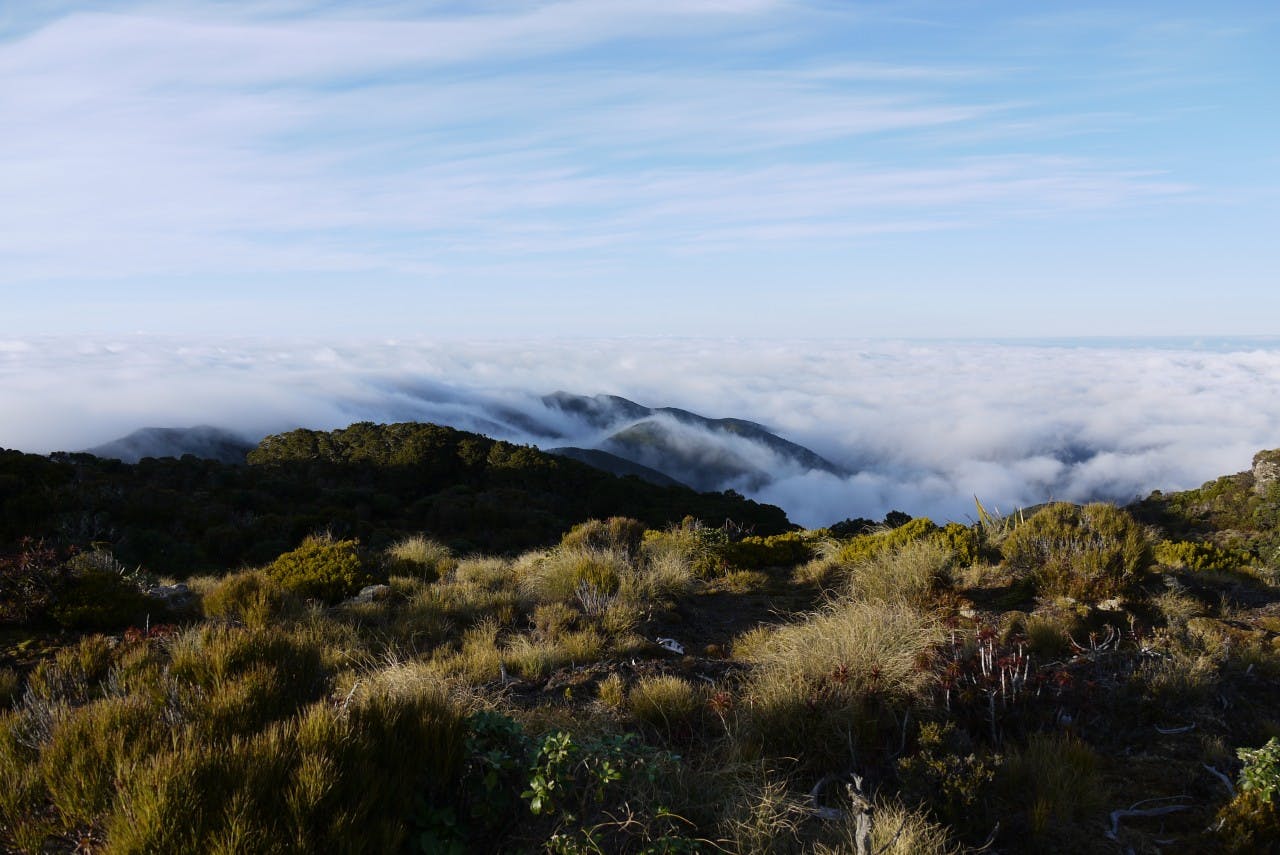
Photo: Alistair Hall
Port Craig was once the hub of an extensive logging operation. Tree felling began in 1917 and the mill opened in 1921 with the expectation it would be processing logs for 50 years. More than 200 people moved to this remote coastal village, but the timber was such poor quality – so badly twisted and fractured by the elements that when the saw was put through it would more often than not turn to dust – that the mill closed in 1928. Stunned workers were given two day’s notice before they were shipped out. The mill reopened in 1930, but then came the Depression and in 1939 the mill was shut down permanently and the tramway, all 1000 tonnes of it, removed.
After visiting the nearby Mussel Beach where the skeletal remains of the mill’s wharf still stand, I can’t understand how anyone could spend more than a few days here, let alone years. The sandflies are relentless and days later I’m still scratching at the itchy welts covering my legs. But on reflection, I have to admit they’re a small price to pay for visiting such a beautiful setting. If the first day of the walk is about the mountains and beech forest, the second day is about human endeavour. Both are equally impressive though for starkly different reasons.
I’m about 20-minutes into the final day of the walk when the mystery bearded trail runner flies past me, again heading in the opposite direction. I catch up to two other walkers, a mother and daughter, who I’ve shared the Hump with over the last two days. “Did you see that man running?” the mother asks. “Yeah, and I saw him yesterday. He must be a trail runner,” I reply. The mother looks doubtful. “He just dropped his pack in front of us and ran off. We think he’s on a training camp for Al Qaeda.”
I’m sure she’s joking, but it’s hard to tell. Her daughter looks sheepish, as if I’ve caught them in the act of doing something they shouldn’t, so perhaps not. A few minutes later the runner catches up to me and before he can pass I ask if he’s a trail runner. “No,” he replies in what sounds like a French accent. “I left my drink bottle at Port Craig and ran back to get it.”
The previous day he had overslept after being kept awake all night by a loud snorer he was sharing the DOC hut with at Port Craig. When he flew past me he was racing to the lookout at Luncheon Rock so he wouldn’t be walking back to the hut in the dark.
It turns out Julien is actually from Belgium and he joins me for the walk back to our cars at Rarakau. The track leads us out of white sand bays, along utterly deserted beaches and through more mature beech and podocarp forest. Then we’re on the home stretch back along Bluecliffs Beach and past the remote cribs dotting the shore.





